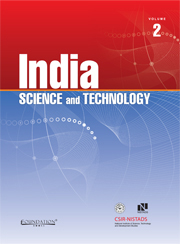Book contents
- Frontmatter
- Contents
- List of Contributors
- List of Tables
- List of Figures
- Acronyms and Abbreviations
- Foreword
- Acknowledgements
- Science and Technology (S&T) and Human Resource
- Science and Technology (S&T) and Innovation Support System: Organisational Arrangement for Promotion of Technological Innovation
- Science and Technology (S&T) and Industry
- Science and Technology (S&T) Output and Patents
- Rural Development – Science and Technology (S&T) Strategies and Capacities
- Index
Science and Technology (S&T) Output and Patents
Published online by Cambridge University Press: 05 September 2013
- Frontmatter
- Contents
- List of Contributors
- List of Tables
- List of Figures
- Acronyms and Abbreviations
- Foreword
- Acknowledgements
- Science and Technology (S&T) and Human Resource
- Science and Technology (S&T) and Innovation Support System: Organisational Arrangement for Promotion of Technological Innovation
- Science and Technology (S&T) and Industry
- Science and Technology (S&T) Output and Patents
- Rural Development – Science and Technology (S&T) Strategies and Capacities
- Index
Summary
Knowledge is becoming a key source of competitive advantage for firms that have the ability to absorb and translate knowledge into a tradable commodity. Countries are investing greater amounts of resources in knowledge creation and dissemination and are looking for opportunities for appropriation. Proper utilisation of knowledge is seen as an enabling tool for strengthening economic and social activity in a country. In this context, it is important to assess the extent to which a country is generating new knowledge and whether any tangible component, that can be appropriated by firms and/or other institutions in the country, can be derived from it. Research papers (primarily in peer reviewed journals) and patents are the most commonly used proxies in assessing intensity of knowledge creation and utilisation. Research articles act as major channels for dissemination of scientific knowledge and their number serve as indicators of scientific production. Patent is a very powerful form of protection. It protects the idea itself irrespective of the way in which it is expressed. Patents are, thus, one of the most useful instruments in transforming raw outputs of science into tradable commodities for knowledge-intensive industries. Patent is seen as output to research and development (R&D) and input to process of innovation. Patent, as indicators of innovation, has limits. Innovation does not always correspond to patented invention and not all patented invention possesses technological or economic value. Not all products are patented and not all patents yield products.
- Type
- Chapter
- Information
- IndiaScience and Technology, pp. 294 - 394Publisher: Foundation BooksPrint publication year: 2013



